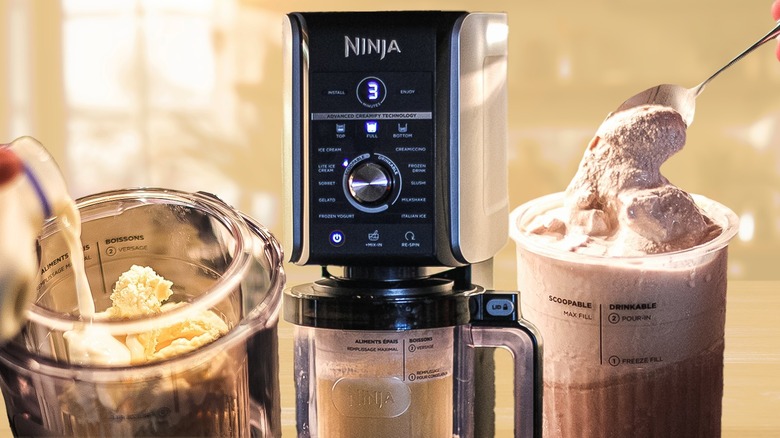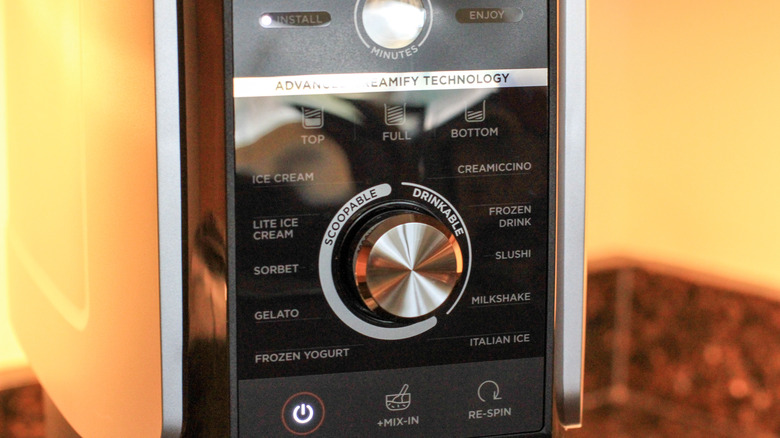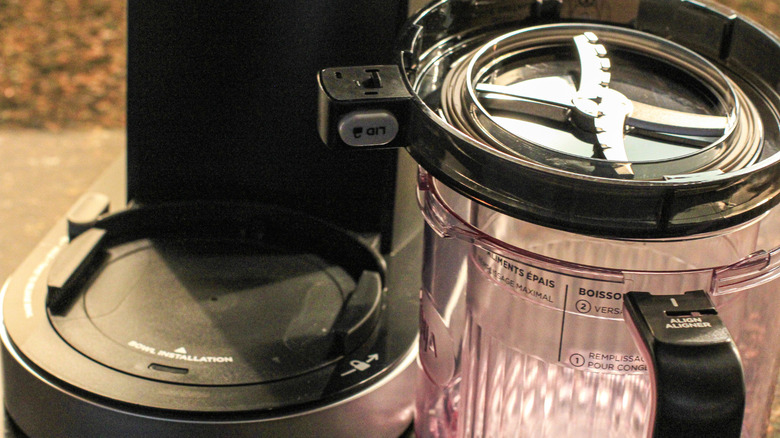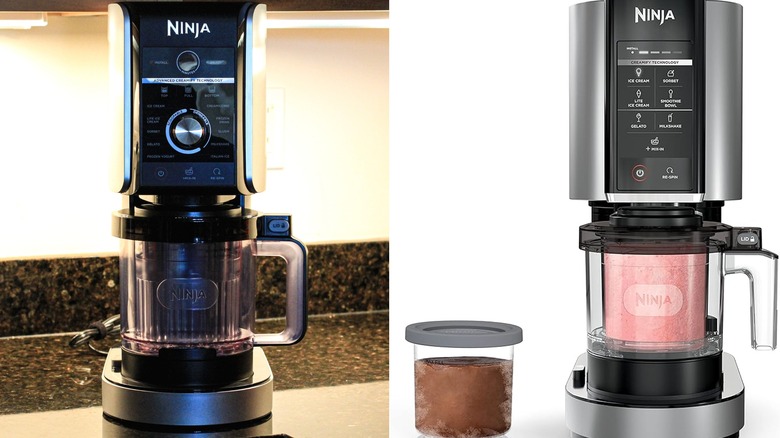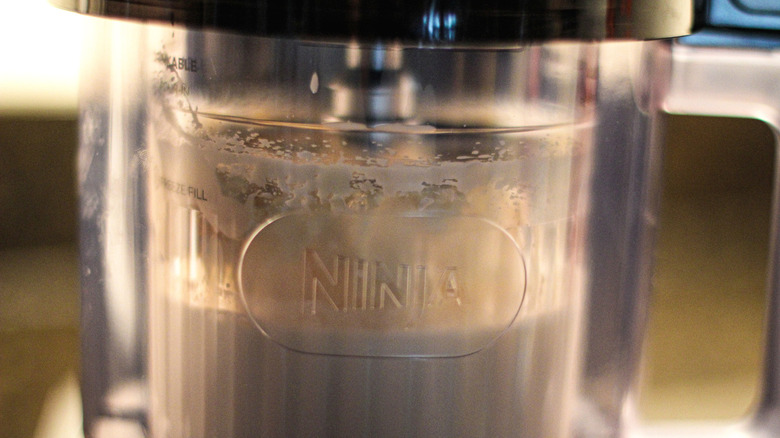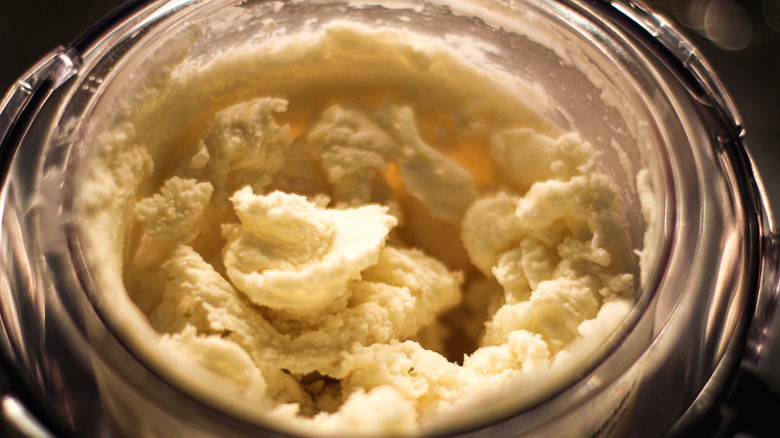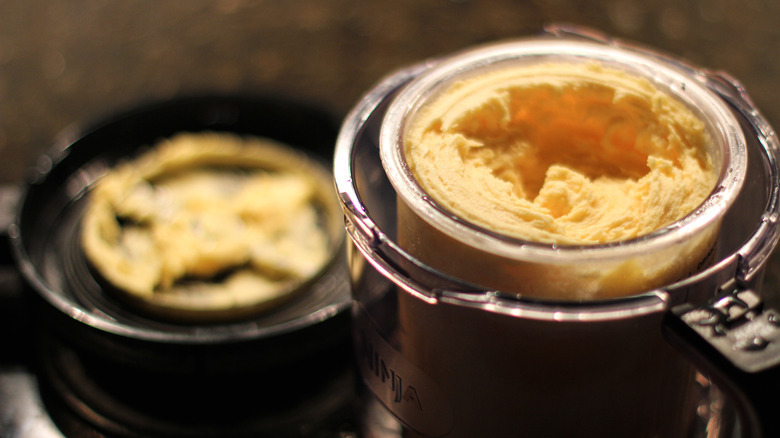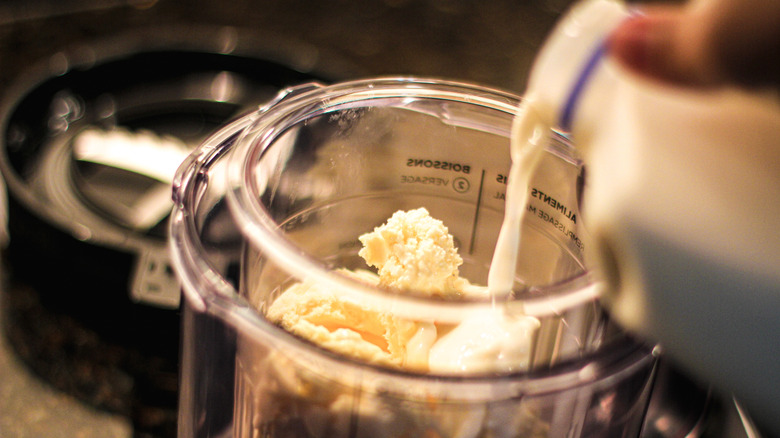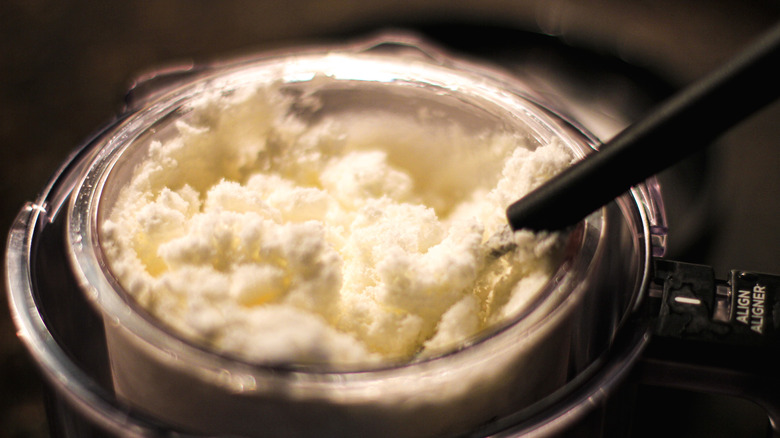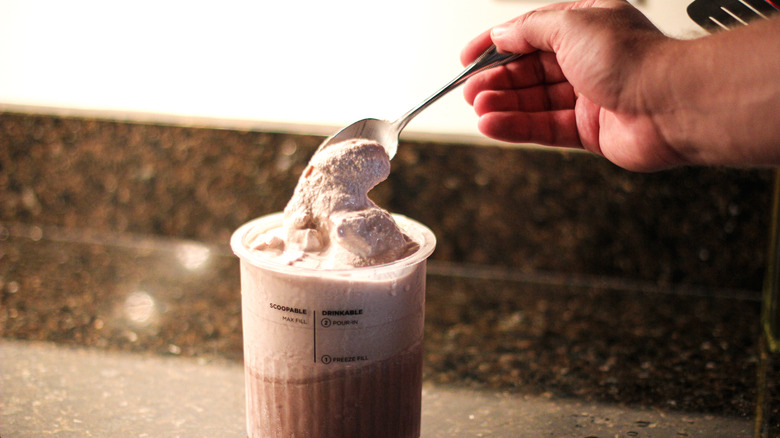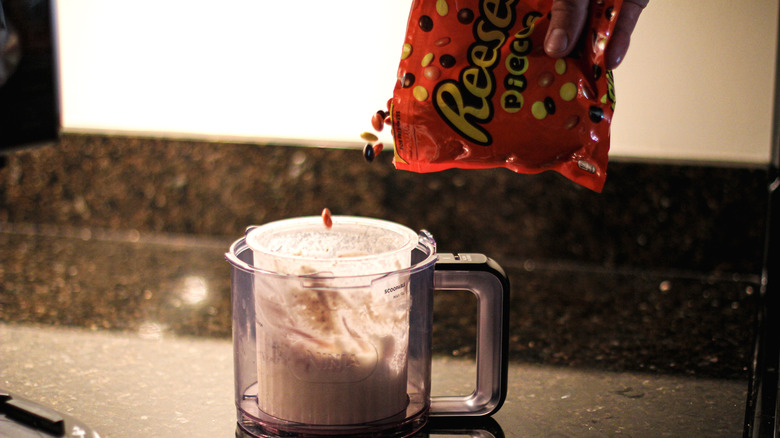Review: The Ninja CREAMi Offers Frosty Euphoria, With Some Serious Caveats
We may receive a commission on purchases made from links.
Making homemade ice cream is an experience that can evoke both feelings of intense nostalgia and intense frustration. For some, those memories are of tossing a double-bagged concoction of rock salt and cream around as a school science project. But if you are in the same boat as I am, you'll remember the feeling of lugging that uncharacteristically heavy ice cream machine out of the back corner of the pantry or basement for a couple of measly scoops. Oh, and don't get me started on the laborious task of hand-churned ice cream.
Luckily, one brand has come out as a pioneer for lightweight kitchen appliances, including ice cream machines: Ninja (aka SharkNinja). This company, which also manufactures everything from vacuums to hair styling tools, released its Ninja CREAMi ice cream machine in 2021. And it's one appliance that folks on social media can't seem to stop talking about. TikTok videos and Instagram reels have popped up since the machine's inception, showing how users put it to use for making everything from protein ice creams with instant pudding mix and protein powder to craft frozen cocktails. I put the Ninja CREAMi to the test to explore its functionality and to see if it was worth purchasing.
Some recommendations are based on firsthand impressions of promotional materials and products provided by the manufacturer.
What is the Ninja CREAMi?
The Ninja CREAMi is the brand's flagship countertop ice cream maker. For this review, I tested the Deluxe model, which can make more frozen dessert options and accommodate a larger size basin compared to the brand's initial model release in 2021.
Essentially, the CREAMi operates just like a normal blender; it has dual-drive motors that puts pressure on a paddle (that kind of looks like the blade you'd see on the bottom of a blender). This cuts down and breaks through the frozen liquid — a function that has been tailored to fit one of the 11 modes on the machine. Not only can you use the CREAMi to make standard ice cream, but you can also use it for sorbets, milkshakes, Creamiccinos (coffee frappés), frozen cocktails, Italian ice, and slushies, too. One interesting feature that sets the Deluxe apart from other models is that you can use the half-and-half function to make one flavor on top of the pint and another one on the bottom.
Each Deluxe machine comes with two 24-ounce deluxe pints; the containers (and removable paddle) are all dishwasher-safe. This machine weighs just about 15 pounds and is around 17 inches tall, which means it's relatively easy to slide under a cabinet or wiggle into a spot on your countertop — though it was about an inch too tall to slide under my cabinet. You'll also get a recipe guide with your machine, which has very important directions for operating it, as well as tons of recipe ideas to get you started. This guide is a really fundamental part of operating this machine and something you won't want to misplace.
Where and how much is the CREAMi?
You can purchase the Ninja CREAMi Deluxe from several major appliance stores. Best Buy offers the CREAMi Deluxe for $229.99, or you can also purchase it on Amazon for $249.99. This machine comes with a one-year manufacturer's warranty regardless of the vendor that you purchase it from.
If you're willing to sacrifice on the functionality of this machine, you can also consider downgrading to the 7-in-1 Ninja CREAMi ice cream maker, which can be purchased on Amazon for $229.99 — offering a little more budget-friendly option for some consumers. And if you really, really want to cut down on how much you're spending, you can do some digging and try to locate the 5-in-1 machine, which is sold at Walmart for $199.99. This machine only makes light and regular ice cream, sorbets, milkshakes, and mix-ins.
Very few brands offer countertop ice cream makers, so it's hard to do a 1-for-1 comparison between brands — at least in terms of functionality. Other brands, like Cuisinart, make large machines that have pre-chilled canisters designed for churning out ice cream on-demand; these will run you upwards of $200 to $300, depending on how industrial of a model you want. Therefore, the Ninja CREAMi Deluxe's price is not too far off from its competitors.
Different Ninja CREAMi models
There are several different CREAMi models out there for folks who are looking to purchase a countertop ice cream maker, as mentioned. The NC301 (7-in-1) model is like the basic version; it makes ice cream, sorbet, light ice cream, gelato, smoothie bowls, and shakes. It weighs slightly less than the Deluxe model that I sampled for this review, but it's nearly the same price. Plus, the Deluxe version of this machine will allow you to make family-sized portions of ice cream; the 7-in-1 only makes pints. You can purchase models on Amazon with either one or two pint-sized containers; the Deluxe that I received automatically came with two 24-ounce (3 cup) containers. And after trying this product, I can confirm — you're going to want to stock up on those extra containers, just in case.
The only reason that I could recommend purchasing the 7-in-1 model over the 11-in-1 is if you want something less bulky, or if you exclusively eat pints of ice cream. But if you want the ability to make your ice cream with half-and-half mix-ins or have the option to re-spin your frozen creation to get them even smoother and creamier, you're going to want to bite the bullet and go for the 11-in-1.
Setting up and operating the CREAMi
You would think that, by the number of bells and whistles on this machine, it would be rather easy to set up and operate. But alas, there is a decent amount of finagling you'll need to do to make sure each of the individual parts on the machine fits in the right spot.
The first thing I had to do was find out how to attach the blade to the top of the cup; this required a lot of back-and-forth with the machine guide and the setup operations flyer that came enclosed in the packaging. It also fit loosely, which made me feel like I was doing something wrong (though the guide told me that this was perfectly okay). Then, the two cups had to be placed inside of one another, like Russian dolls, so that they could be assembled and attached to the machine. A couple of cranks, movement, and "what does this dos" later, and I was able to get the machine up and running.
If I didn't have the operations guide, I would not have been able to set up this machine, let alone make ice cream with it. Other appliances I've worked with in the past (like my KitchenAid stand mixer, which only has lock/unlock and speed knobs) have been a little simpler to operate and set up than this machine. While I think that a decent read-through of the manual before you even pull the machine out of the packaging would be helpful, right off the bat, I could tell that this machine was not built with consumer ease in mind. And if you chose to go rogue, I would assume that it would lead to you breaking part of this very expensive machine.
Taste test: ice cream
The first test I performed with this CREAMi was a basic ice cream. I wanted to ensure that I was following the manufacturer's directions properly, so I selected a recipe from the book itself: the vanilla ice cream base. I figured it was really hard to mess up a vanilla ice cream, and that the Ninja test kitchen would have this basic recipe tried, tested, and perfected.
The instructions called for mixing softened cream cheese (an unlikely addition to ice cream), heavy cream, white sugar, vanilla extract, and milk together in a separate bowl before adding it to the vessel. Since this was the first recipe I sampled with the machine, I made sure that I did my research beforehand — and learned that the mixture had to be frozen for 24 hours (yes, a whole day) and kept flat in the freezer so it would evenly freeze. After the 24 hours was up, I nestled the pint container inside of the vessel and got to work. The machine wasn't obnoxiously loud, and the ice cream was blended well within about four minutes. Its flavor was just standard, plain ice cream — nothing was really bad about it.
I then decided to test the base by adding in peanut butter cups on the top half and Reese's Pieces on the bottom. In order to do a half-and-half, though, you have to add the mix-ins to just the top, blend it, then remove that ice cream and process the bottom separately. So, while the packaging makes it seem like you can have two-pints-in-one, this is not the case. Though, the machine cut through the mix-ins easily, and although it was more labor-intensive than it should have been, I ended up with two separate ice creams with a single base.
Taste test: fruit sorbet
The second recipe I sampled with the machine was a fruit sorbet. It's important to note that the brand is very clear that you cannot use the CREAMi as a blender for solid, frozen fruits. Rather, you have to instead mash either bananas, pineapple, or orange (very clearly, only those fruits, otherwise you could potentially "damage the machine"). Or, you can do as I did and take the easy way out: Use canned fruit instead.
The recipe in the book called for 40 ounces of canned fruit in syrup. Again, the brand was finicky and asserted that the fruit had to be in syrup (or juice); you couldn't use no-sugar-added fruit. While the syrup might lend itself well to a sweet flavor, it gives you less options for controlling the cloyingness of this dessert. Like the ice cream, it needed to be frozen for 24 hours in the syrup before it could be processed. I chose canned peaches for this recipe because, well, I like peaches — and I like peach sorbet. And honestly, I was impressed by the texture of this ice cream. It was quite creamy and really like ice cream, though it was entirely dairy-free.
The one downside that I would note, besides the limited variety of fruits that could be used, was that there were small chunks of ice and fruit on the outside of the container than remained even after this ice cream was processed. It was almost like the edges of the blade were not large enough to reach the edges of the container.
Taste test: milkshake
The milkshake was the only recipe I made with my CREAMi that didn't call for the mixture to be frozen for an entire 24-hour window before it was ready to use. The preparation was relatively easy; just combine the pre-made ice cream and the milk together in the unit and set it on the milkshake setting. This recipe book recommended adding 2¼ cups of ice cream and a ¾ cup milk, and shared that it could also be made with add-ins (like chocolate chips, syrup, and more). The guide didn't give an exact ratio for the ideal amount of mix-ins like how the ice cream recipe recommended ⅓ cup for a whole container. Rather, the "milkshakes inspirations" page of the guide suggested everything from ¼ to ½ cup. Creative license, I guess?
The other caveat for this recipe is that you have to have pre-made ice cream handy. The book didn't specify if I could use the ice cream I already made in the CREAMi — so I bought a cheap vanilla ice cream base instead to eliminate any variables. I thought it was also interesting that I didn't have to use ice in this machine, like a traditional milkshake. I also added a dash of coffee syrup for some flavor (it's a Rhode Island thing). The quality of this shake was average — about what I would expect from a diner. It wasn't especially thick, nor was it too thin. It was easy to either suck up with a straw or eat with a spoon — nothing cosmic.
Overall, it seems like this is an added use for your CREAMi, but it shouldn't be the sole reason why you buy the machine. A cheap blender would do a more-than-adequate job at making this creation. I also thought that this machine seemed to be especially noisy for only pureeing a liquid and soft, cheap vanilla ice cream together.
Taste test: protein ice cream
If there was one recipe that I was truly and genuinely excited about trying in this CREAMi, it was the protein ice cream. I went rogue on this one and selected a recipe from a separate online source. It recommended combining Fairlife high-protein milk with a little bit of no-sugar-added instant pudding mix. Fairlife is ultra-filtered milk, so it's very protein-dense, but still has the same consistency as normal milk.
This recipe called for the ice cream, once it had been frozen for 24 hours, to be processed on the light ice cream setting. However, the main issue with this setting, which may also be the result of the starting recipe containing very little sugar, is that the top half of the light ice cream turned to flavorless snow. It was very light, not creamy, and practically devoid of anything that could remotely be compared to "ice cream." But the recipe foresaw this being an issue and called for adding extra liquid, re-spinning it, and trying it again.
Before I tried this suggestion (which indeed made the ice cream better), I dug around the bottom of the container. When I did this, I noticed that the bottom half of this pint actually resembled ice cream — or really, frozen pudding — and it wasn't entirely bad-tasting. But it seems so wasteful to make a half of a container of ice cream only for the top half to be virtually unusable. It also seems a bit silly to have to add more liquid, go back, and try again. I firmly believe that if this recipe was re-adjusted and the ice cream was made on the regular setting (rather than the light one), it would have offered different, more favorable results.
Taste test: frozen hot chocolate
I would be remiss if I didn't try a beverage with my CREAMi. I selected the brand's recipe for frozen hot chocolate, which — like its other recipes — had to be frozen for 24 hours before making it. In order to make the recipe described in the book, I had to microwave the milk together with the hot chocolate powder (rest assured, its containers are indeed microwave-safe). Then, after the freezing was finished, I had to add even more milk into the mixture to give it some creaminess before processing it on the Creamiccino setting.
I strongly believed that the Creamiccino setting on this frozen hot chocolate turned it into a very wet version of soft serve. The other person I had sampling this with me remarked that it tasted just like a Wendy's Frosty. This ice cream-ish drink wasn't as thick as a Starbucks Frappuccino or frozen coffee beverage. It wasn't noticeably icy either, but it did have that unique creaminess that made it lean more toward soft serve than anything else. But it wasn't structurally sound enough for a cone.
Still, this perfectly sippable beverage would be a refreshing treat at any time of year — and it isn't something that I think you could recreate with a standard blender. Consider me impressed.
Is the Ninja CREAMi worth it?
I consider myself to be someone who hates buying a kitchen gadget only to pull it out once in a blue moon. The Ninja CREAMi has neat functionality and uses, sure, but I really only think that it would be useful if you find yourself eating copious, and I mean copious, amounts of ice cream — or you're someone who loves to finagle with small-batch ice cream recipes.
This machine certainly presents a learning curve, but I don't think that it should turn you off entirely from purchasing it. While it's definitely more complicated to operate than other kitchen appliances, with time, it will become more intuitive. In order to decide if this machine is worth it, though, you really have to consider what kinds of things you want to make with it, and how much of it you're making. Don't buy the Ninja CREAMi if you're just making frozen margaritas; it's a loud machine that can essentially make almost every beverage that a cheap kitchen blender can. Besides, a kitchen blender can process ice and whole fruit, while the Ninja CREAMi can't.
The other major limitation to this machine is its practicality. You have to freeze ice cream, gelato base, and sorbet, among other selections, for at least 24 hours before you make them, which means you'd essentially have to meal prep dessert. And is perfectly good store-bought ice cream that bad — or that expensive — to warrant a $250 DIY machine? I'll say this: The CREAMi is a nifty machine. But it's not something I, as an average consumer, would purchase for my home kitchen.
